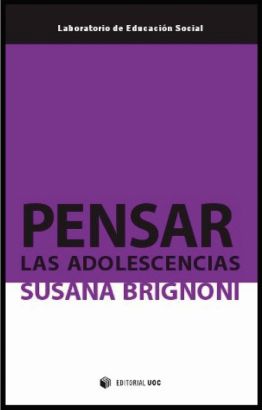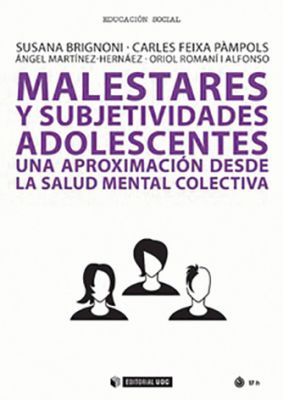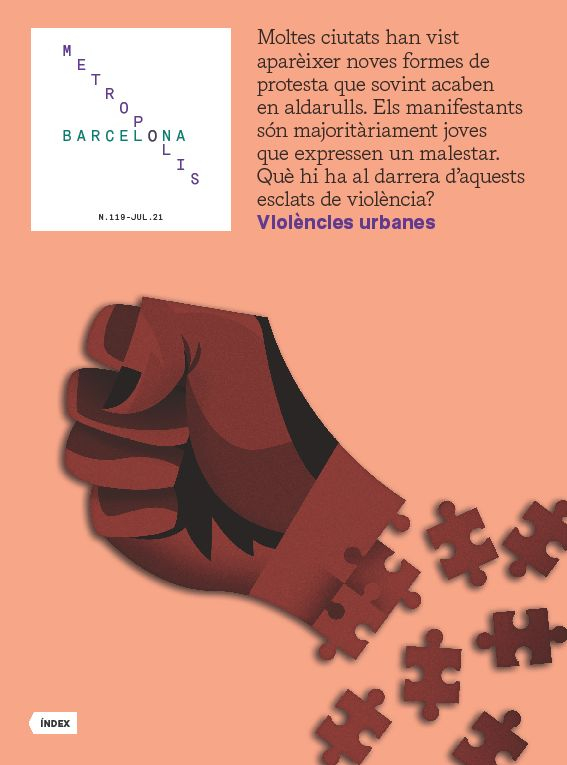Violence, amidst noise and silence
- Dossier
- Sep 21
- 13 mins

We cannot discuss the violence of young people without considering the position or the discourses on the basis of which they have previously felt violated. Violence can constitute the social symptom of a rage that, besides destroying what it attacks, can consume the person who perpetrates it. Protests convey the difficulty that young people have in representing themselves in the future and feeling respected. However, contrary to popular belief, anger and violence surface when there is still hope that something may change.
In various spheres or discourses, violence is prominent today as one of the most relevant symptoms of our present-day reality. Even if it does not occur, it is palpable as a shadow, as a possible threat to everyday life. Violence is often associated with young people, but children are also linked to it.[1] Sometimes we hear talk of “tyrannical children”, and they are expected to become “violent adolescents or young people”. Warning signs or factors that increase the risk of violence are listed. We often hear that children, adolescents or young people are increasingly violent outside and inside the home.[2] And there is also talk of a phenomenon known as “inverted violence”,[3] with which a climate of social alarm is created. “Inverted violence” is children’s mistreatment of parents, a problem that, according to experts, stems from parents’ excessive permissiveness, among other reasons. That said, in light of this concept, the transcending question is: if we talk about inverted violence, would that imply we believe there is violence “in the right direction”? Does this idea of “inverted violence” allude to a possible nostalgia for what was once part of “normality” and that was expressed in the father’s “authority”?
We are in an age in which the signifier violence seems to go together with different forms of social bond. This leads us to believe that “violence” thus promoted is part of a discourse that tends to naturalise a reality created under the following effects:
- identifications (“violent young people”);
- common-sense meanings (“from a violent family only violent children can be expected”);
- pleasure (“the supposed satisfaction found in violence”).
This naturalisation must be challenged and, to this end, the signifier violence must be pluralised. In the social sphere, it is more about the “violence” taken as responses that the subjects, in our case young people, come up with when faced with different situations of discomfort. They are plural and, at the same time, singular.
What are we talking about when we talk about violence?
Violence is often presented as something removed from the “civilised”, as if it were inhumane. Sometimes forms of violence are also covered up, denied or silenced. But can we think of the phenomenon or phenomena of violence as removed from or beyond civilisation? Or even: can we think of them as an inhumane phenomenon?
Violence emerges as one of the great taboos of our society. It is a taboo whose opposite, as Fernández Villanueva[4] points out, is the “obsession with appeasement”. However, that which strikes us as so new, is not in reality. The issue of violence has always been an issue and a concern.[5] Take Hobbes as an example, who in 1651 already underlined that man was a wolf to his fellow man, implying the presence of a drive for destructiveness inherent in every human being. Later, the “social contract” arose as a means of dealing with this impulsiveness. The contract implies a way of putting into words what is presented outside the word. The contract is, then, a means of treatment. To a certain extent, we may think that the idea of contract brings an interpretation into play: violence is contrary to the articulated structure of the word.
[1] This article is a reflection based on the research study we are carrying out in the Residential Support Service of the DGAIA [Directorate General for Child and Adolescent Care] of the Nou Barris Foundation for Mental Health (F9B). The research study is entitled “Violencias y desamparos” [Violence and Abandonment] and will be concluded in early 2022.
[2] Sarabia, B. “Violencia invertida” [Inverted Violence], in El Cultural, 1 July 2011.
[3] Barbolla, D., Masa, E., and Díaz, G. Violencia invertida [Inverted Violence]. Gedisa. Barcelona, 2011.
[4] Fernández Villanueva, C. Jóvenes violentos. Causas psicosociológicas de la violencia en grupo [Violent Young People. Psychosociological Causes of Group Violence]. Icaria Editorial, Barcelona, 1998.
[5] Ons, S. “La violencia contemporánea. Notas sobre la paranoia social” [Contemporary Violence. Notes on Social Paranoia], in Virtualia, no. 18.
Violence is often presented as something removed from the “civilised”, as if it were inhumane. Sometimes forms of violence are also covered up, denied or silenced.
But the contract in turn forgets that subjective manifestations of aggressiveness cannot be fully addressed by the word. There is an inherent component to human beings that does not get caught up in words. That is something that, when we deal with young people, we can observe on a daily basis: when we invite a young person to reflect on their violent behaviour, they can accept that invitation, even recognise what is being suggested to them and, regardless of that, continue a cycle in which their behaviours are repeated. Sometimes they can create a connection between their violent behaviour and a feeling that violates them from within, and this is progress in itself.
Anger
What do we do when we speak and what do we say when we act? Asking this question is essential when working with young people, given that there is sometimes a certain dissociation between doing and saying, between acting and knowing. That is why it is necessary to ask ourselves questions that allow us to introduce any behaviour into the structure of the word and language. Word and language are the instruments that we shall use from psychoanalysis in an endeavour to ensure that the subject, no matter how old they are, does not get trapped in a dimension of the feelings that can consume their being, destroying them. We are seeking out instruments that make that seemingly disjointed behaviour connect to something else that is not of the same substance.
We start out from the idea that passions do not necessarily express an error of judgement but rather openly show the relationship between unspoken words and the body. There is a fire that burns in the body and, so that it does not completely burn the subject hosting it, expresses itself in different ways. That fire is named by many young people as rage. “Rage is justified” was one of the placards featured in the Pablo Hasél protests in Barcelona. They speak of a rage that takes them over, that shakes them up and that runs through their bodies. We wonder, then, if we can choose to feel or not feel anger. How can we reflect on that feeling outside the body it is inhabiting? How can we think of a feeling that, at times, builds a connection with others and that becomes a social symptom? We start out from the idea that this anger is expressed through violent behaviour, and the problem that this poses is that, in addition to destroying what it attacks, it can consume the being that perpetrates it.
The protest may have different causes, but one of the main ones is the difficulty that young people have today in knowing how to represent themselves in the future.
Social symptom
I do not think you can choose to feel or not feel rage, anger or wrath, at least the first time. Anger takes us over: it takes over the body and the senses and pushes us to act. It takes the form of impulse, which implies a pressure within the body that does not cease until it gains some satisfaction, an outlet, even if it is false.[1] This pressure tends to express the malaise of young people as regards those issues that open a path to channel their protest in the social sphere. The protest may have different causes, but I think that one of the main ones is the difficulty that young people have today in knowing how to represent themselves in the future, and that feeling, that many express, of getting stuck in a position, a kind of “dead-end” impasse. Today that getting stuck is related to economic crises, the crisis of political discourse or the crisis that the real standstill triggered by COVID-19 has meant for our lives.
Somehow, young people’s feelings have been left without a place in institutions, without their protection. Cristina Corea[2] wonders whether some practices of young people respond to institutions’ difficulty to offer “places of enunciation” or to their loss of their capacity to institute. Certain young people, she tells us, are not constituted taking the institution as a framework, but rather experiences. Violence, street protests, are experiences that include the other to whom they are directed. This is not new either. In 2005, some young people took to the streets to burn bins on the outskirts of Paris. It was a social outbreak in which they called themselves “rebels”, but they pointed out that the French Interior Minister called them “scum”. They explain how they were hastened to respond at that level: “Since we are scum, we are going to give this racist a job cleaning up... Words do more harm than blows.” In a way, we can say that young people “obey” the place that the other gives them, even if it calls them to the worst place. That is why when we think about the possibility of a change of place, it is determined by what is offered by the other: the place from where adults look at young people is fundamental.
We cannot speak of violence without reflecting on the discourses or practices that may have previously violated a young person.
Daniel Roy[3] affirms that there is something that no longer works as it did before at the level of discourse, in other words, in terms of what creates social ties between people, and that bears implications both in young people’s bodies and mindsets. It is this change in the setting modes of the bond that affects the forms of behaviour and responses that they present to us.
Violence emerges as responses of a paradoxical nature. The subject attacks in the place where they themselves feel attacked. But this last condition, feeling attacked, is frequently cleaved from their consciousness. They “don’t know anything about it”, in some cases; in others, they do not feel concerned by what happened or they blame the other person, “who provoked it”. We also sometimes come across the minimisation of violent behaviour: it manifests itself through the young person’s surprise on being subjected to an excessive punishment by the adult. Therein lies a real surprise, an enigmatic dimension resulting from the short circuit between the act and its significance.
[1] Ubieto, J. R. Bullying. Una falsa salida para los adolescents [Bullying. A False Outlet for Adolescents]. Ned Ediciones, Barcelona, 2016.
[2] Corea, C. “Marcas y cicatrices. Sobre las operaciones de los chicos en el desfondamiento” [Marks and Scars. On the Activites of Young People in the Collapse] in Pedagogía del aburrido. Escuelas destituidas, familias perplejas [Pedagogy of the Bored. Schools Destitute, Families Baffled]. Paidós, Buenos Aires, 2010.
[3] Roy, D. “El mal de la juventud” [The Ill of Young People], in Carretel, no. 14, Bilbao, September 2017.
 © Nicolás Aznárez
© Nicolás AznárezViolence emerges as responses of a paradoxical nature. The subject attacks in the place where they themselves feel attacked.
I think an endeavour must be made to allow the subject inhabited by violence to redirect the current scenario in which the violence takes place towards this “other scenario” in which they themselves were violated. Finding the springs of what was fixed as an impulse, without words, can help to address and even to deactivate it. This means determining whether what happens there is of the nature of repetition, which is the subject’s way of starting to produce something, since it is never repeated exactly the same way, or is of the nature of iteration,[1] which is the reproduction of what is inscribed in one go and is beyond the field of meaning. In iteration it is a fixed point; we can think of it, for example, in the field of addiction, in which “experience does not teach anything”.[2] That is why we speak of addiction and not addition, since it is not a sum. In addiction, there is always the first time, it is always one, one, one... This distinction between repetition and iteration is not trivial, since it determines the treatments to be followed and the possible destinations of violence.
Based on psychoanalysis, we can think of the different declensions of violence as being what is most intrinsically human.
Violence can be a means in search of an end. However, when we speak today of unleashed violence, violence appears to us as an end in itself. It surfaces in its nonsensical dimension. It is when violence is constantly updated without halting the mark that it was at the outset and that leads the subject, over and over again, to unchecked repetition.
On the basis of psychoanalysis we can affirm that violence is inherent in the bond; for instance, when we talk about aggressive tension[1] with a peer. It is a tension that is not necessarily going to be unleashed. It can remain in one’s thought.
Human violence
In other words, from the outset, contrary to the common discourse that frequently thinks of violence as inhumane, based on psychoanalysis, we can think of the different declensions of violence as being what is most intrinsically human.
So is violence a natural reaction? Is it irrational? Hannah Arendt[2] is of the opposite opinion: studying extreme situations, such as the experience of concentration camps, she claims that a person, in situations of dehumanisation, loses anger and violence, and becomes submissive.
Anger and violence arise when it is suspected that something may still change, when the sense of justice is offended. In other words, to a certain extent, they show us a perspective in which the subject is still hoping for something, although it is difficult for us to understand the way in which they are showing their hope.
This is something that I frequently observe in the young people I work with: they have a great sense of justice and are acutely aware of the other who acts as a reference point to them. They observe and judge their ways of interacting and do not accept what they consider to be false. Young people have a fundamental demand they direct to the other as best they can. It is about the demand for respect. Lacadée[3] claims that this is young people’s quintessential demand today. It is a paradoxical demand: they are often disrespectful and yet they demand respect. Should we meet this demand? I think that, although it proves contradictory, it is about giving in to this demand. The feeling of disrespect emerges, according to Sennett,[4] when people feel that they are not seen, that they are not being considered. In some way, it sets a condition: “not being seen”. In young people, this condition leads to segregation and sometimes, to avoid it, a big ruckus is made. Thus, respect means to include. And professionals, the reference points that surround young people, therefore have to carry out acts that involve acknowledgement.
It is important for professionals to know that the opposite of the angry and violent response, Arendt points out, is not the rational, but the inability to let oneself be moved when applying capricious rules. What is irrational in violence is when it turns on alternative people who have not caused it. But that, contrary to what some discourses may hold, does not make it a causeless or unmotivated violence.
Delving into these causes can put professionals in uncomfortable situations, since finding the answers is not easy or one-way. However, I think that a certain discomfort denotes the good position vis-à-vis young people. Surely, when we feel too comfortable, we are not putting ourselves in the right place. Working with young people always implies bringing the dimension of the body into play. We often overlook that what “creates body” in a discourse and in a practice is what is not fixed, but what morphs and is unique. Including the body implies “letting ourselves feel uncomfortable”[5] and being willing to drop the routine meanings with which we classify young people. Ultimately, it is to take what young people teach us from the side of teaching. To accept their challenge.
[1] Lacan, J. “La agresividad en psicoanálisis” [Aggressiveness in Psychoanalysis], in Escritos 1, Mexico, 1989.
[2] Arendt, H. Sobre la violencia [About Violence], Cuadernos de Joaquín Mortiz, Mexico, 1970.
[3] Lacadée, P. El despertar y el exilio. Enseñanzas psicoanalíticas sobre la adolescencia [Awakening and Exile. Psychoanalytic Teachings on Adolescence]. Gredos, Madrid, 2010.
[4] Sennett, R. El respeto. Sobre la dignidad del hombre en un mundo de desigualdad [Respect. On a Person’s Dignity in a World of Inequality]. Anagrama, Barcelona, 2003.
[5] Lacadée, P. op. cit.
Recommended publications
 Pensar las adolescenciasUOC, 2012
Pensar las adolescenciasUOC, 2012 Malestares y subjetividades adolescentesUOC, 2018
Malestares y subjetividades adolescentesUOC, 2018
The newsletter
Subscribe to our newsletter to keep up to date with Barcelona Metròpolis' new developments




